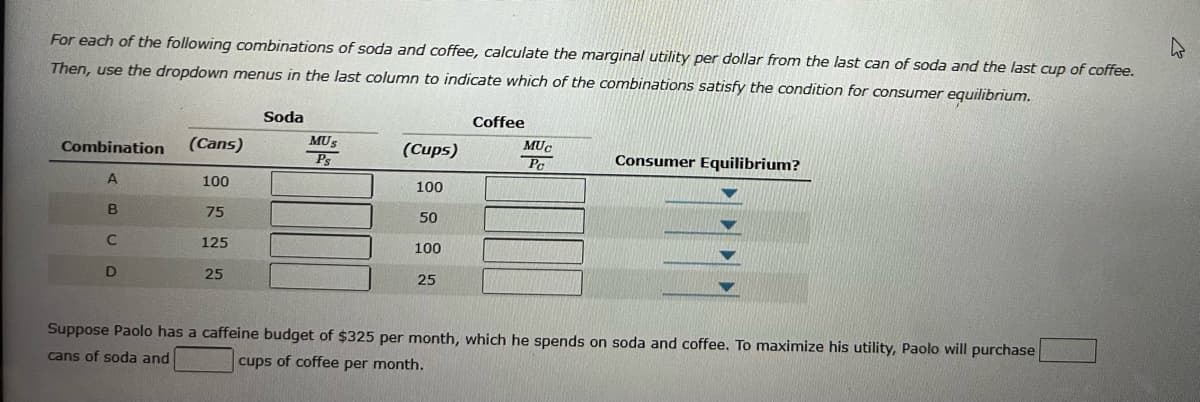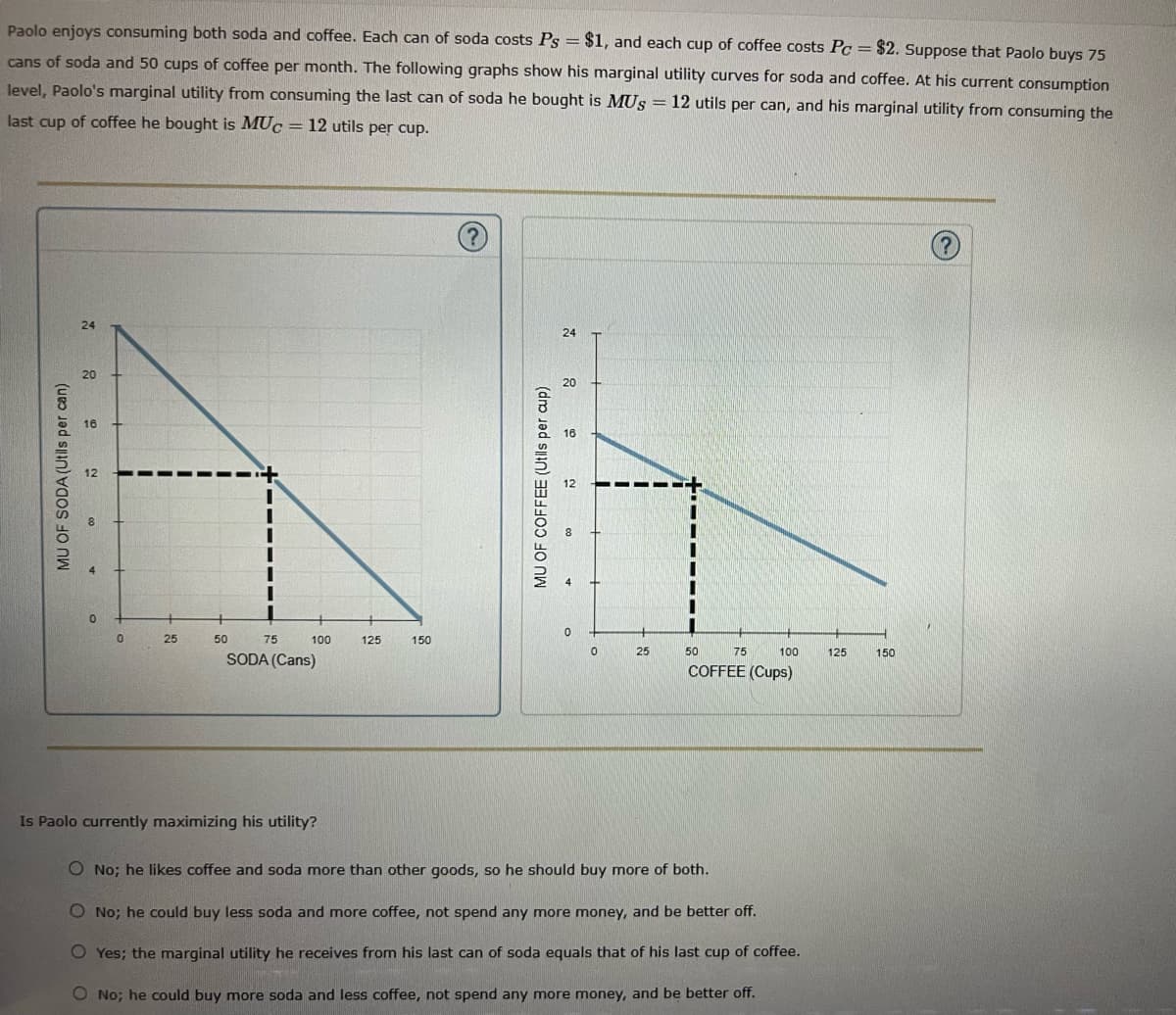Paolo enjoys consuming both soda and coffee. Each can of soda costs Ps = $1, and each cup of coffee costs Pc = $2. Suppose that Paolo buys 75 cans of soda and 50 cups of coffee per month. The following graphs show his marginal utility curves for soda and coffee. At his current consumption level, Paolo's marginal utility from consuming the last can of soda he bought is MUS = 12 utils per can, and his marginal utility from consuming the last cup of coffee he bought is MUC = 12 utils per cup. 24 20 20 16 25 50 75 100 125 150 25 50 75 100 125 150 SODA (Cans) COFFEE (Cups) Is Paolo currently maximizing his utility? O No; he likes coffee and soda more than other goods, so he should buy more of both. O No; he could buy less soda and more coffee, not spend any more money, and be better off. Ehis lact cup of coff0 MU OF SODA (Utls per can) 24 MU OF COFFEE (Utils per aup) N co
Paolo enjoys consuming both soda and coffee. Each can of soda costs Ps = $1, and each cup of coffee costs Pc = $2. Suppose that Paolo buys 75 cans of soda and 50 cups of coffee per month. The following graphs show his marginal utility curves for soda and coffee. At his current consumption level, Paolo's marginal utility from consuming the last can of soda he bought is MUS = 12 utils per can, and his marginal utility from consuming the last cup of coffee he bought is MUC = 12 utils per cup. 24 20 20 16 25 50 75 100 125 150 25 50 75 100 125 150 SODA (Cans) COFFEE (Cups) Is Paolo currently maximizing his utility? O No; he likes coffee and soda more than other goods, so he should buy more of both. O No; he could buy less soda and more coffee, not spend any more money, and be better off. Ehis lact cup of coff0 MU OF SODA (Utls per can) 24 MU OF COFFEE (Utils per aup) N co
Chapter10: Consumer Choice Theory
Section: Chapter Questions
Problem 8P
Related questions
Question
100%

Transcribed Image Text:For each of the following combinations of soda and coffee, calculate the marginal utility per dollar from the last can of soda and the last cup of coffee.
Then, use the dropdown menus in the last column to indicate which of the combinations satisfy the condition for consumer equilibrium.
Soda
Coffee
Combination
(Cans)
MUS
(Cups)
MUC
Pe
Ps
Consumer Equilibrium?
100
100
75
50
C
125
100
25
25
Suppose Paolo has a caffeine budget of $325 per month, which he spends on soda and coffee. To maximize his utility, Paolo will purchase
cans of soda and
cups of coffee per month.

Transcribed Image Text:Paolo enjoys consuming both soda and coffee. Each can of soda costs Ps = $1, and each cup of coffee costs Pc = $2. Suppose that Paolo buys 75
cans of soda and 50 cups of coffee per month. The following graphs show his marginal utility curves for soda and coffee. At his current consumption
level, Paolo's marginal utility from consuming the last can of soda he bought is MUS = 12 utils per can, and his marginal utility from consuming the
last cup of coffee he bought is MUC = 12 utils per cup.
24
20
20
16
25
50
75
100
125
150
25
50
75
100
125
150
SODA (Cans)
COFFEE (Cups)
Is Paolo currently maximizing his utility?
O No; he likes coffee and soda more than other goods, so he should buy more of both.
O No; he could buy less soda and more coffee, not spend any more money, and be better off.
O Yes; the marginal utility he receives from his last can of soda equals that of his last cup of coffee.
O No; he could buy more soda and less coffee, not spend any more money, and be better off.
MU OF SODA (Utils per can)
24
MU OF COFFEE (Utils per aup)
Expert Solution
This question has been solved!
Explore an expertly crafted, step-by-step solution for a thorough understanding of key concepts.
This is a popular solution!
Trending now
This is a popular solution!
Step by step
Solved in 2 steps with 1 images

Knowledge Booster
Learn more about
Need a deep-dive on the concept behind this application? Look no further. Learn more about this topic, economics and related others by exploring similar questions and additional content below.Recommended textbooks for you

Exploring Economics
Economics
ISBN:
9781544336329
Author:
Robert L. Sexton
Publisher:
SAGE Publications, Inc

Economics: Private and Public Choice (MindTap Cou…
Economics
ISBN:
9781305506725
Author:
James D. Gwartney, Richard L. Stroup, Russell S. Sobel, David A. Macpherson
Publisher:
Cengage Learning

Microeconomics: Private and Public Choice (MindTa…
Economics
ISBN:
9781305506893
Author:
James D. Gwartney, Richard L. Stroup, Russell S. Sobel, David A. Macpherson
Publisher:
Cengage Learning

Exploring Economics
Economics
ISBN:
9781544336329
Author:
Robert L. Sexton
Publisher:
SAGE Publications, Inc

Economics: Private and Public Choice (MindTap Cou…
Economics
ISBN:
9781305506725
Author:
James D. Gwartney, Richard L. Stroup, Russell S. Sobel, David A. Macpherson
Publisher:
Cengage Learning

Microeconomics: Private and Public Choice (MindTa…
Economics
ISBN:
9781305506893
Author:
James D. Gwartney, Richard L. Stroup, Russell S. Sobel, David A. Macpherson
Publisher:
Cengage Learning


